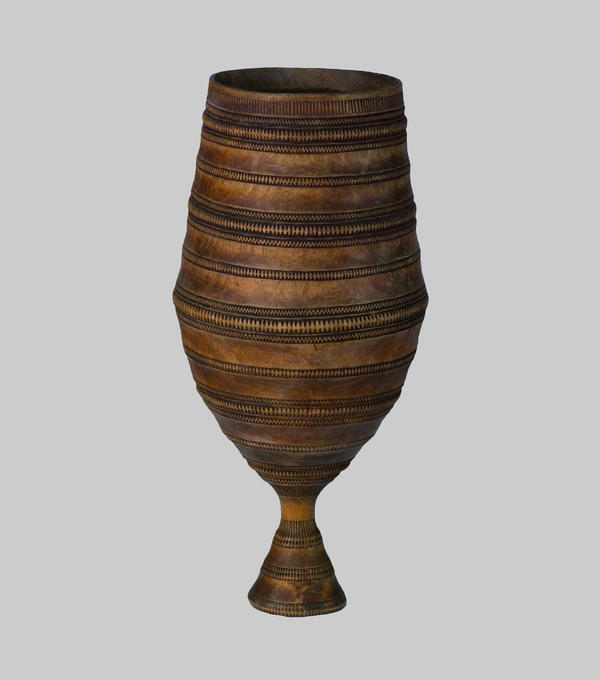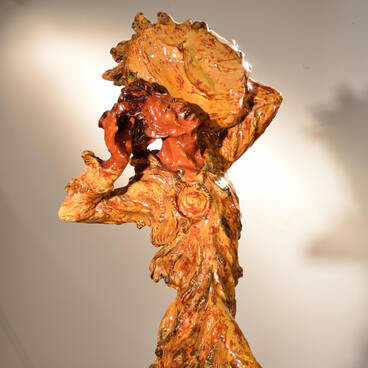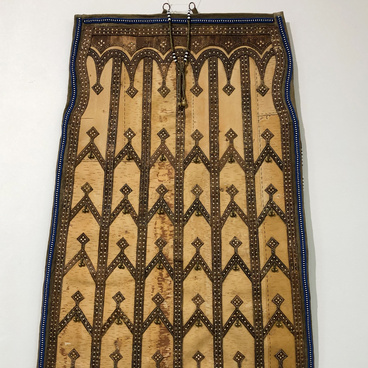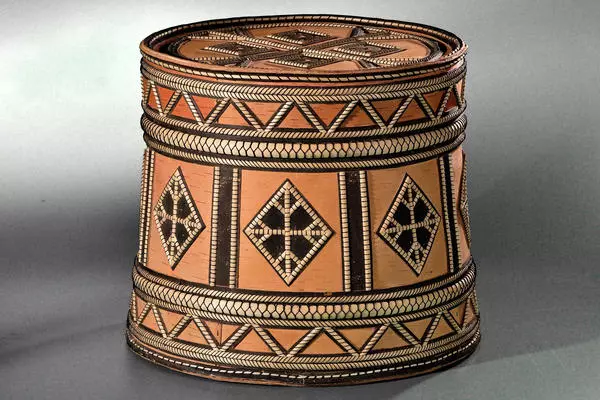#1
Bride’s Box, Choron, Happachi aana
#2
#5
#8
Semyon Chernogradsky has been working with birch bark for more than thirty five years making both household utensils and decorative items. He learnt this craft from his mother, Maria Chernogradskaya, a well-known bark art master in Yakutia. Their works are part of the collections of Yakutia’s major museums.
The “Bride”s Box. Enne Ihit” was made by Semyon Chernogradsky in 2013. Traditionally, such boxes were part of a girl’s dowry and were used for keeping needlework accessories. They were handed down from mothers to daughters.
The box is made of birch bark. Crafts made from this material were of different shapes, most often round or oval. They had an insert bottom and a removable lid with a rim around the edge. The rim made the lid close tightly.
Boxes were richly decorated with ornaments in a variety of techniques, with the focus on the lid and the front of the box. The box on display is decorated with repeating patterns of diamonds and triangles, openwork and horsehair weaving.
Such items are mainly made from tree bark, a material that is valued for its flexibility and warm light shades. Most often craftsmen work with birch bark or larch bark. Horsehair ornamental patterns and stitching, openwork, embossing, and toning are used to accentuate the natural properties of the material.
Birch bark craft has been practiced in Yakutia since old times, but reached its peak in the 19th century. During thid period that simple household utensils made from birch bark gave way to more decorative items, while birch bark craft developed into a creative art form.
This traditional craft is still popular today. Yakutia can boast the names of well-known bark artists, Chernogradsky being one of them. He was born in Yakutia in 1959, in the village of Eselyakh. For a long time, he worked in animal husbandry. But later he decided to continue the family craft and took serious interest in artistic processing of birch bark. He merges art, tradition and impeccable technical implementation to achieve excellence in his works.
The “Bride”s Box. Enne Ihit” was made by Semyon Chernogradsky in 2013. Traditionally, such boxes were part of a girl’s dowry and were used for keeping needlework accessories. They were handed down from mothers to daughters.
The box is made of birch bark. Crafts made from this material were of different shapes, most often round or oval. They had an insert bottom and a removable lid with a rim around the edge. The rim made the lid close tightly.
Boxes were richly decorated with ornaments in a variety of techniques, with the focus on the lid and the front of the box. The box on display is decorated with repeating patterns of diamonds and triangles, openwork and horsehair weaving.
Such items are mainly made from tree bark, a material that is valued for its flexibility and warm light shades. Most often craftsmen work with birch bark or larch bark. Horsehair ornamental patterns and stitching, openwork, embossing, and toning are used to accentuate the natural properties of the material.
Birch bark craft has been practiced in Yakutia since old times, but reached its peak in the 19th century. During thid period that simple household utensils made from birch bark gave way to more decorative items, while birch bark craft developed into a creative art form.
This traditional craft is still popular today. Yakutia can boast the names of well-known bark artists, Chernogradsky being one of them. He was born in Yakutia in 1959, in the village of Eselyakh. For a long time, he worked in animal husbandry. But later he decided to continue the family craft and took serious interest in artistic processing of birch bark. He merges art, tradition and impeccable technical implementation to achieve excellence in his works.
#9
Full name: Bride’s Box. Enne Ihit
Author: Semyon Stepanovich ChernogradskyDate: 2013
Technique: birch bark, horsehair, willow, stitching, weaving, applique, staining
Dimensions: 35,5×44,5×51,3; 10×44,3×46,3 cm
Collection: Republic of Sakha Museum of Art (Yakutia)
Copyright: Republic of Sakha Museum of Art (Yakutia)
Goskatalog Number: 14850030
Goskatalog Number: 14850030
#3
Choron
#4
#6
Famous Soviet ethnographer and archaeologist Aleksey Okladnikov wrote: 'Сhorons are exceptional property of Yakut material culture. No other nation has got such kind of vessels now.'
The choron is national Yakut tableware, which is used for keeping and drinking koumiss – a sour milk product. The vessel is produced from wood – most often from birch tree – and embellished by an ornamental pattern. In shape, it resembles a goblet on one or three small legs. The process of its creation is handmade from the beginning to the end, that is why chorons do not repeat one another and they contain individual author’s style.
This choron on one leg was made by an unknown author in the second half of the 18th century. He chose traditional horizontal ornamental pattern taraahoyuu for the vessel decoration. It is made up of equal parallel sections that are located upright and close to each other. Researchers believe that such kind of picture symbolised fertility and lines were associated with gold sunlight or with long hair of patron goddesses of agriculture.
Names of many patterns for choron had symbolical significance and were connected with way of life and basic activity of the Yakuts. A certain group of ornamental patterns were destined for every part of bowl. For example, combed and toothed ornamental patterns were placed in the form of triangles and rhombs at the edge of neck. Vertebral pattern was used for the central part of vessel. Its name originates over the external similarity of picture with animals’ vertebra.
In the culture of the Sakha people, choron was not just a tableware, but rather a token of wealth and family abundance. Therefore, since ancient time, there was a tradition to bring the vessel with koumiss to the newly married couple at the Yakut weddings.
Also, such goblet is used during the main Yakut holiday – Ysyakh. It is celebrated on summer solstice on June, 21 and it is associated with the onset of the warm season. Usually, the celebration is accompanied with road dances, sports competitions and koumiss drinking. During this rite, the shaman asks Gods to give blessing to koumiss and after that, he prays over it.
The choron is national Yakut tableware, which is used for keeping and drinking koumiss – a sour milk product. The vessel is produced from wood – most often from birch tree – and embellished by an ornamental pattern. In shape, it resembles a goblet on one or three small legs. The process of its creation is handmade from the beginning to the end, that is why chorons do not repeat one another and they contain individual author’s style.
This choron on one leg was made by an unknown author in the second half of the 18th century. He chose traditional horizontal ornamental pattern taraahoyuu for the vessel decoration. It is made up of equal parallel sections that are located upright and close to each other. Researchers believe that such kind of picture symbolised fertility and lines were associated with gold sunlight or with long hair of patron goddesses of agriculture.
Names of many patterns for choron had symbolical significance and were connected with way of life and basic activity of the Yakuts. A certain group of ornamental patterns were destined for every part of bowl. For example, combed and toothed ornamental patterns were placed in the form of triangles and rhombs at the edge of neck. Vertebral pattern was used for the central part of vessel. Its name originates over the external similarity of picture with animals’ vertebra.
In the culture of the Sakha people, choron was not just a tableware, but rather a token of wealth and family abundance. Therefore, since ancient time, there was a tradition to bring the vessel with koumiss to the newly married couple at the Yakut weddings.
Also, such goblet is used during the main Yakut holiday – Ysyakh. It is celebrated on summer solstice on June, 21 and it is associated with the onset of the warm season. Usually, the celebration is accompanied with road dances, sports competitions and koumiss drinking. During this rite, the shaman asks Gods to give blessing to koumiss and after that, he prays over it.
#7
Full name: Choron
Author: Unknown
Date: the second half of the 18th century
Technique: wood, hollowing, carving incised triangular, contour
Dimensions: 37,5×14×18,7×7,4 cm
Collection: Republic of Sakha Museum of Art (Yakutia)
Copyright: Republic of Sakha Museum of Art (Yakutia)
Goskatalog Number: 003381454
Author: Unknown
Date: the second half of the 18th century
Technique: wood, hollowing, carving incised triangular, contour
Dimensions: 37,5×14×18,7×7,4 cm
Collection: Republic of Sakha Museum of Art (Yakutia)
Copyright: Republic of Sakha Museum of Art (Yakutia)
Goskatalog Number: 003381454
#10
Happakhchi aana
#11
#12
In traditional Yakut families young girls lived in separate quarters (‘happakhchi’), where no strangers were allowed. Happakhchi aana (Yakut) is a wooden screen that was placed at the entrance to the room of an unmarried woman in order to separate her from the rest of the house.
The name of such a screen is derived from the Yakut word ‘happakh’, which means ‘cover’. This screen from the collection of the National Fine Arts Museum of the Republic of Sakha (Yakutia) was made by Yelizaveta Olesova in 2015. In her works she makes use of ancient technologies and creates Yakut national fur clothing and various household utensils.
The door has a traditional trapezoidal shape with curved top corners. It consists of three birch bark layers, which are sewn together with horsehair. As a basis, the back side of the door is applied to the wood bark. The front layer of birch bark is laid with the light side, which is called ‘drawing’. On it, an ornamental applique is sewn: it is covered with black paint with drawings cut through the top. The screen pattern consists of parallel zigzag rows with rhombuses at the top. The top of the ornamental pattern carries diamond-shaped pieces with small carved circles, through which one can see the second, light-coloured layer of birch bark. Additionally, the master decorated the curtain with pendants made of beads and coins.
The birch bark art has been known in Yakutia since ancient times. This material became popular due to its flexibility and a pleasant light colour. ‘Elley gathered birch bark, put up sticks, tied them up at the top and covered them with bark decorated with patterns, cogs and clippings, thus forming an urasa, a house’, that is how the craft is described in the Yakut oral poems ‘Olonkho’, which appeared over a thousand years ago.
For a long time, birch bark products - screens, buckets, boxes, dishes - were made exclusively for domestic use. In the 20th century the situation changed: simple and practical things gave way to decorative pieces. Craftsmen began to decorate their works with geometric figures, images of plants or animals, beads and metal plates. To the present days birch bark artwork remains a popular craft in Yakutia.
The name of such a screen is derived from the Yakut word ‘happakh’, which means ‘cover’. This screen from the collection of the National Fine Arts Museum of the Republic of Sakha (Yakutia) was made by Yelizaveta Olesova in 2015. In her works she makes use of ancient technologies and creates Yakut national fur clothing and various household utensils.
The door has a traditional trapezoidal shape with curved top corners. It consists of three birch bark layers, which are sewn together with horsehair. As a basis, the back side of the door is applied to the wood bark. The front layer of birch bark is laid with the light side, which is called ‘drawing’. On it, an ornamental applique is sewn: it is covered with black paint with drawings cut through the top. The screen pattern consists of parallel zigzag rows with rhombuses at the top. The top of the ornamental pattern carries diamond-shaped pieces with small carved circles, through which one can see the second, light-coloured layer of birch bark. Additionally, the master decorated the curtain with pendants made of beads and coins.
The birch bark art has been known in Yakutia since ancient times. This material became popular due to its flexibility and a pleasant light colour. ‘Elley gathered birch bark, put up sticks, tied them up at the top and covered them with bark decorated with patterns, cogs and clippings, thus forming an urasa, a house’, that is how the craft is described in the Yakut oral poems ‘Olonkho’, which appeared over a thousand years ago.
For a long time, birch bark products - screens, buckets, boxes, dishes - were made exclusively for domestic use. In the 20th century the situation changed: simple and practical things gave way to decorative pieces. Craftsmen began to decorate their works with geometric figures, images of plants or animals, beads and metal plates. To the present days birch bark artwork remains a popular craft in Yakutia.
#13
Full name: Happakhchi aana
Author: Yelizaveta Dmitrievna Olesova
Date: 2015
Technique: Birch bark, horsehair, metal, leather, bead strings, glass beads, stitchwork, embroidery, applique
Dimensions: 129×78 cm
Collection: Republic of Sakha Museum of Art (Yakutia)
Author: Yelizaveta Dmitrievna Olesova
Date: 2015
Technique: Birch bark, horsehair, metal, leather, bead strings, glass beads, stitchwork, embroidery, applique
Dimensions: 129×78 cm
Collection: Republic of Sakha Museum of Art (Yakutia)
Copyright: Republic of Sakha Museum of Art (Yakutia) Goskatalog Number: 1604416216044162
read morehide
00:00
00:00
1x
0
Open in app
Share







